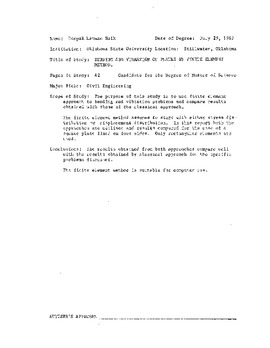| dc.contributor.author | Naik, Deepak Laxman | |
| dc.date.accessioned | 2016-01-27T22:26:46Z | |
| dc.date.available | 2016-01-27T22:26:46Z | |
| dc.date.issued | 1967-07 | |
| dc.identifier.uri | https://hdl.handle.net/11244/26928 | |
| dc.description.abstract | Scope of Study: The purpose of this study is to use finite element approach to bending and vibration problems and compare results obtained with those of the classical approach. | |
| dc.description.abstract | The finite element method assumes to start with either stress distribution or displacement distribution. In this report both the approaches are utilized and results compared for the case of a square plate fixed on four sides. Only rectangular elements are used. | |
| dc.description.abstract | Conclusions: The results obtained from both approaches compare well with the results obtained by classical approach for the specific problems discussed. | |
| dc.description.abstract | The finite element method is suitable for computer use. | |
| dc.format | application/pdf | |
| dc.language | en_US | |
| dc.rights | Copyright is held by the author who has granted the Oklahoma State University Library the non-exclusive right to share this material in its institutional repository. Contact Digital Library Services at lib-dls@okstate.edu or 405-744-9161 for the permission policy on the use, reproduction or distribution of this material. | |
| dc.title | Bending and vibration of plates by finite element method | |
| osu.filename | Thesis-1967R-N155b.pdf | |
| osu.accesstype | Open Access | |
| dc.type.genre | Master's Report | |
| dc.type.material | Text | |
| thesis.degree.discipline | Civil Engineering | |
| thesis.degree.grantor | Oklahoma State University | |
